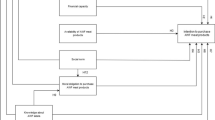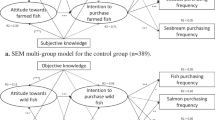Abstract
Communicating the process quality of ethically produced food effectively is of highest interest to policy makers, organizations, retailers and producers in order to enhance ethical food production and increase ethical label use. The objective of this paper is to unveil the effectiveness of different communication treatments in regard to changing purchase behavior of different consumer groups. Different communication material for beef produced according to consumer expectations was compiled and applied in a consumer survey—incorporating a choice experiment and a questionnaire—with 676 respondents in three cities of Germany. A Latent Class Mixed Logit Model was basis to identify different consumer segments and their response to the different communication treatments. The effects of different communication treatments unveil the importance to address information in an objective manner. Target groups could be enlarged through the assessment of clear, objective information. Moreover, most consumers were more likely to refrain from choosing a cheap beef product from conventional, barn-based rearing. Hence, consumers might be interested in reducing their overall consumption of beef and prefer the consumption of high value ethical beef with less frequency. Producers, market actors and policy makers should realize that a high share of consumers, not only smaller target groups, value ethical food and may be ready to change their consumption habits, if they are adequately informed.
Similar content being viewed by others
Notes
For the group which received the documentary film, an estimation procedure was possible, when skipping 54 observations. For the group which received the leaflet, no segmentation was conceivable at all.
References
Apostolidis, C., & McLeay, F. (2016). Should we stop meating like this? Reducing meat consumption through substitution. Food Policy, 65, 74–89.
Bechtold, K.-B., & Abdulai, A. (2014). Combining attitudinal statements with choice experiments to analyze preference heterogeneity for functional dairy products. Food Policy, 47, 97–106.
BMEL\. (2017). Deutschland, wie es isst. Ernaehrungsreport 2017. Berlin. Retrieved from http://www.bmel.de/SharedDocs/Downloads/Broschueren/Ernaehrungsreport2017.pdf?__blob=publicationFile.
Borkfelt, S., Kondrup, S., Röcklinsberg, H., Bjørkdahl, K., & Gjerris, M. (2015). Closer to nature? A critical discussion of the marketing of “Ethical” animal products. Journal of Agricultural and Environmental Ethics, 28(6), 1053–1073.
Briggeman, B. C., & Lusk, J. L. (2011). Preferences for fairness and equity in the food system. European Review of Agricultural Economics, 38(1), 1–29.
Cooper, B., Rose, J., & Crase, L. (2012). Does anybody like water restrictions? Some observations in Australian urban communities. Australian Journal of Agricultural and Resource Economics, 56(1), 61–81.
de Jonge, J., & van Trijp, H. (2014). Heterogeneity in consumer perceptions of the animal friendliness of broiler production systems. Food Policy, 49, 174–185.
de Pelsmacker, P., & Janssens, W. (2007). A model for fair trade buying behaviour: The role of perceived quantity and quality of information and of product-specific attitudes. Journal of Business Ethics, 75(4), 361–380.
Dentoni, D. T., Tonsor, G., Calantone, R., & Christopher Peterson, H. (2014). Disentangling direct and indirect effects of credence labels. British Food Journal, 116(6), 931–951.
Eurobarometer. (2007). Attitudes of consumer towards animal welfare: Special Eurobarometer 270. Retrieved from http://ec.europa.eu/public_opinion/archives/ebs/ebs_270_en.pdf.
Eurobarometer. (2016). Attitudes of Europeans towards animal welfare.: Special Eurobarometer 442. Retrieved from http://ec.europa.eu/COMMFrontOffice/PublicOpinion/index.cfm/Survey/getSurveyDetail/instruments/SPECIAL/surveyKy/2096.
European Commission. (2010). Labelling related to animal welfare. Retrieved from https://ec.europa.eu/food/animals/welfare/other_aspects/labelling_en.
Field, A. P. (2009). Discovering statistics using SPSS (3rd ed.). Introducing statistical methods. London: Sage Publications.
Fliess, B., Lee, H-J., Dubreuil, O. L., & Agatiello, O. (2007). CSR and Trade: Informing consumers about social and environmental conditions of globalised production (OECD trade policy working paper No. 47–PART I).
German Federal Research Institute of Nutrition and Food. (2008). National Nutrition Survey (II). Karlsruhe. Retrieved from https://www.mri.bund.de/fileadmin/MRI/Institute/EV/NVS_II_Abschlussbericht_Teil_1_mit_Ergaenzungsbericht.pdf.
German Federal Statistical Office. (2014). Genesis-online Databank. Retrieved from Federal Statistical Office (Destatis) website: https://www-genesis.destatis.de/genesis/online/data;jsessionid=6D9A2A0F67C339C4BD244A7A68FF1383.tomcat_GO_1_1?Menu=Willkommen.
Greene, W. (2016). Nlogit. Reference guide.
Grunert, K. G., Hieke, S., & Wills, J. (2014). Sustainability labels on food products: Consumer motivation, understanding and use. Food Policy, 44, 177–189.
Hempel, C., & Hamm, U. (2016). How important is local food to organic-minded consumers? Appetite, 96, 309–318. https://doi.org/10.1016/j.appet.2015.09.036.
Hensher, D. A., Rose, J., & Greene, W. A. (2015). Applied choice analysis (2nd ed.). Cambridge: University Press.
Hess, S., & Beharry-Borg, N. (2012). Accounting for latent attitudes in willingness-to-pay studies: The case of coastal water quality improvements in Tobago. Environmental & Resource Economics, 52(1), 109–131.
Honkanen, P., & Olsen, S. O. (2009). Environmental and animal welfare issues in food choice. British Food Journal, 111(3), 293–309.
Janssen, M., Busch, C., Rödiger, M., & Hamm, U. (2016a). Motives of consumers following a vegan diet and their attitudes towards animal agriculture. Appetite, 105, 643–651.
Janssen, M., Rödiger, M., & Hamm, U. (2016b). Labels for animal husbandry systems meet consumer preferences: Results from a meta-analysis of consumer studies. Journal of Agricultural and Environmental Ethics, 29(6), 1071–1100.
Jonell, M., Crona, B., Brown, K., Rönnbäck, P., & Troell, M. (2016). Eco-labeled seafood: Determinants for (blue) green consumption. Sustainability, 8(9), 884.
Lancaster, K. (1966). A new approach to consumer theory. Journal of Political Economy, 74(2), 132–157.
Langen, N. (2011). Are ethical consumption and charitable giving substitutes or not?: Insights into consumers’ coffee choice. Food Quality and Preference, 22(5), 412–421.
Loebnitz, N., & Aschemann-Witzel, J. (2016). Communicating organic food quality in China: Consumer perceptions of organic products and the effect of environmental value priming. Food Quality and Preference, 50, 102–108.
Lusk, J. L., & Briggeman, B. C. (2009). Food values. American Journal of Agricultural Economics, 91(1), 184–196.
Lusk, J. L., & Norwood, F. B. (2016). Some vegetarians spend less money on food, others don’t. Ecological Economics, 130, 232–242.
Lusk, J. L., Roosen, J., & Fox, J. A. (2003). Demand for beef from cattle administered growth hormones or fed genetically modified corn: A comparison of consumers in France, Germany, the United Kingdom, and the United States. American Journal of Agricultural Economics, 85(1), 16–29.
Lusk, J. L., & Schroeder, T. C. (2004). Are choice experiments incentive compatible? A test with quality differentiated beef steaks. American Journal of Agricultural Economics, 86(2), 467–482.
McFadden, D. (1973). Conditional logit analysis of qualitative choice behavior (pp. 105–142). Frontiers in Economis: Academic Press.
Ökobarometer. (2016). Ökobarometer 2016: Repräsentative Bevölkerungsbefragung im Auftrag des Bundesministeriums für Ernährung und Landwirtschaft (BMEL). Retrieved from https://www.bmel.de/SharedDocs/Downloads/Ernaehrung/Oekobarometer2016.html.
Paulssen, M., Temme, D., Vij, A., & Walker, J. L. (2014). Values, attitudes and travel behavior: A hierarchical latent variable mixed logit model of travel mode choice. Transportation, 41(4), 873–888.
Sax, J. K., & Doran, N. (2016). Food labeling and consumer associations with health, safety, and environment. Journal of Law, Medicine and Ethics, 44, 630–638.
Simoes, J. S., Marsico, E. T., da Cruz, A. G., de Freitas, M. Q., Doro, L. H., & Conte-Junior, C. A. (2015). Effect of sustainability information on consumers’ liking of freshwater prawn (Macrobrachium rosenbergii). Journal of the Science of Food and Agriculture, 95(15), 3160–3164. https://doi.org/10.1002/jsfa.7055.
Thurstone, L. L. (1927). Psychophysical analysis. The American Journal of Psychology, 38(3), 368–389.
Tonkin, E., Coveney, J., Meyer, S. B., Wilson, A. M., & Webb, T. (2016). Managing uncertainty about food risks - Consumer use of food labelling. Appetite, 107, 242–252.
Train, K. E. (2009). Discrete choice methods with simulation. New York: Cambridge University Press.
Valor, C., Carrero, I., & Redondo, R. (2014). The influence of knowledge and motivation on sustainable label use. Journal of Agricultural and Environmental Ethics, 27(4), 591–607.
van Loo, E. J., Caputo, V., Nayga, R. M., & Verbeke, W. (2014). Consumers’ valuation of sustainability labels on meat. Food Policy, 49, 137–150.
van Loo, E. J., Hoefkens, C., & Verbeke, W. (2017). Healthy, sustainable and plant-based eating: Perceived (mis)match and involvement-based consumer segments as targets for future policy. Food Policy, 69, 46–57.
van Wezemael, L., Ueland, O., Rodbotten, R., de Smet, S., Scholderer, J., & Verbeke, W. (2012). The effect of technology information on consumer expectations and liking of beef. Meat Science, 90(2), 444–450.
Vanhonacker, F., & Verbeke, W. (2014). Public and consumer policies for higher welfare food products: Challenges and OPPORTUNITIES. Journal of Agricultural and Environmental Ethics, 27(1), 153–171.
Verbeke, W. (2008). Impact of communication on consumers’ food choices. The Proceedings of the Nutrition Society, 67(3), 281–288.
Yadavalli, A., & Jones, K. (2014). Does media influence consumer demand? The case of lean finely textured beef in the United States. Food Policy, 49, 219–227.
Author information
Authors and Affiliations
Corresponding author
Rights and permissions
About this article
Cite this article
Risius, A., Hamm, U. Exploring Influences of Different Communication Approaches on Consumer Target Groups for Ethically Produced Beef. J Agric Environ Ethics 31, 325–340 (2018). https://doi.org/10.1007/s10806-018-9727-6
Accepted:
Published:
Issue Date:
DOI: https://doi.org/10.1007/s10806-018-9727-6




